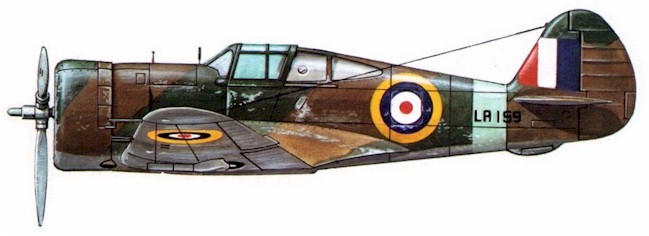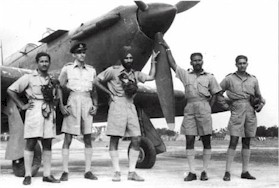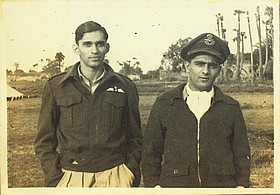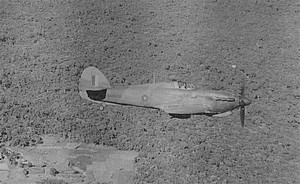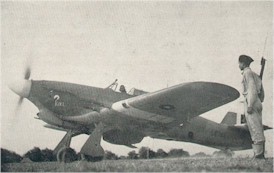When No.1 Squadron, Indian Air Force went into operations in February 1942 against the Japanese in Burma, it carried the hopes and future growth prospects of the Indian Air Force with it. Other than the little that is on the record about Sqn Ldr Majumdar, who was to perish in a crash a few years later, not much is known about the other officers and men who were to be the ‘First in the Burma Skies’. We present a series of profiles of the personnel who were on the original team of the Tigers, No 1 Squadron, as they were being built up. The first in series of these articles is a profile of Air Commodore Homi Shapurji Ratnagar, who saw two tours of ops on the Burma Front, and is now (in 2003) 83 years old and settled in Hyderabad.
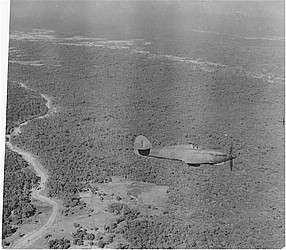 When No.1 Squadron, Indian Air Force went into operations in February 1942 against the Japanese in Burma, it carried the hopes and future growth prospects of the Indian Air Force with it. The operations of the unit would be closely watched – and it was only after the successful campaign led by the legendary Jumbo Majumdar that more IAF units were raised, and more and more Indians were given the opportunity to see aerial action in the Second World War. Ironically, other than the little that is on the record about Sqn Ldr Majumdar, who was to perish in a crash a few years later, not much is known about the other officers and men who were to be the ‘First in the Burma Skies’.
When No.1 Squadron, Indian Air Force went into operations in February 1942 against the Japanese in Burma, it carried the hopes and future growth prospects of the Indian Air Force with it. The operations of the unit would be closely watched – and it was only after the successful campaign led by the legendary Jumbo Majumdar that more IAF units were raised, and more and more Indians were given the opportunity to see aerial action in the Second World War. Ironically, other than the little that is on the record about Sqn Ldr Majumdar, who was to perish in a crash a few years later, not much is known about the other officers and men who were to be the ‘First in the Burma Skies’.
We present a series of profiles of the personnel who were on the original team of the Tigers, No 1 Squadron, as they were being built up. The first in series of these articles is a profile of Air Commodore Homi Shapurji Ratnagar, who saw two tours of ops on the Burma Front, and is now 83 years old and settled in Hyderabad.
Introduction
Homi Ratnagar hailed from the Parsi Colony area in Bombay. Having lost his father at the young age of 13, he was not particularly interested in college once he had completed his matriculation. He had always wanted to take up flying as a career and become an airline pilot. Aviation at that time was catching the world’s imagination – and India, though under British rule, was not far behind. There were regular flights to India by Imperial Airways – and the sight of small aircraft taking off from Juhu aerodrome was to remain familiar for many years.
So when he was 17, Ratnagar told his mother that intended to take up flying as a career. Supported by his mother, he managed to raise some money and join the Bombay Flying Club to learn flying. This was the year 1937.
Over the next two years, Ratnagar accumulated nearly 100 flying hours and also got his A-1 Pilot’s License. In those days the cost of flying lessons was around Rs 35 per hour. It was clear that Ratnagar needed more flying hours before he could seriously think of starting a career in civil aviation, but the financial resources of the family had already been stretched. Ratnagar’s mother was unable to raise more funds for further flying training. At this crucial juncture, events that were unfolding elsewhere were to offer a direction to the young pilot.
When the Second World War broke out in 1939, applications were invited for pilots and navigators in the Indian Air Force. Ratnagar was one of the first to apply. He had to wait for some time before the call came for him to join up. Preference in those days was given to pilots who were already well established in civil aviation careers. A few experienced airline pilots were selected as Observers/Navigators under the IAFVR program. Ratnagar, with just flying club experience, had to wait for some time. When the IAF first called up people in those times, many stalwarts of civil aviation in India had signed up. PC Lal, Rajaram, Atmaram, KL Sondhi etc were among those who joined the IAF as Observers, although already qualified as civil pilots.
Ratnagar also applied in response to the call for Observers, but when he received a reply to his application in the form of a call up letter – asking him to report on a particular date at Risalpur — it had a PostScript underneath. That the IAF was taking him into the Pilots’ stream straight away.
To his surprise, when he reached Risalpur on 14 June 1940, there was nothing like the usual batch of new entrants waiting for further instructions. Ratnagar was the only person to have reported that day!
No. 3 Pilots Course at FTS Risalpur and Ambala
Ratnagar’s entry was designated No. 3 Pilots Course, though he was the only pilot in it. There was no commissioning ceremony or procedure. Ratnagar approached the officer in charge in civilian clothes with the reporting letter. The officer took a look at him and then told him to get outfitted in the Khaki Drill uniform with the rank of Pilot Officer. By end of the day, Ratnagar was wearing the khaki uniform with the thin braid of a Pilot Officer on his shoulder.
Ratnagar’s commission, as well as the commissions of officers in No.s 1 and 2 PCs preceding and other courses that came later, were IAF Volunteer Reserve commissions. Wearing the titles “IAFVR” on his sleeves, Ratnagar was one of the first of the ‘Direct Entry’ Indian pilots. Theirs were not permanent commissions and their future in service was quite vague once the war was over [1].
Since he already had more than 100 hours of flying experience, Ratnagar was not required to go through initial training. He was sent to No.1 Flying Training School in Risalpur, to start flying on the Wapiti directly. Risalpur was a good place to stay with low costs of living. Ratnagar recollects that a whole day’s meals would cost just Rs 2.50, which does not even pay for a cup of tea today!
Not long afer he joined up, Ratnagar was hit by a severe bout of malaria. It was serious enough for him to be hospitalised and for his mother to come to visit him. Ultimately the two to three months that Ratnagar spent in hospital due to malaria delayed the date that he passed out of the course at Risalpur.
After recovering from the illness, on 26th November, Ratnagar was sent to FTS Ambala for further flying training. The training would continue till May 1941. Just before that, another big batch of freshly inducted trainees joined up at FTS Ambala. This batch comprised the 4th PC, which included notables-to-be such as Pilot Officers Moolgavkar, Minoo Engineer, Ranjan Dutt, and others.
Among his contemporaries of that time, Ratnagar struck up a friendship with two other Parsi officers. Piloo Reporter and Minoo Engineer both hailed from Bombay and came from well-off families. Reporter came from an affluent Parsi family in Bombay, who owned a huge building complex right on Marine Drive and a cinema theatre in the same area. Reporter also owned and drove a 1940 Chevrolet car, which he had bought for Rs 3000, a princely sum in those years.
Once during the training, the course was given a mid-term leave of 10 days. Public traveling facilities in those days would not have given the pilots any chance of going to their hometowns in far-off corners of the country and getting back within this relatively short period. Even for the three Parsi officers, Bombay was too far off to go by public transport and come back within ten days. Then Reporter had an idea. He approached Ratnagar and Minoo and suggested that they should drive his Chevrolet all the way from Ambala to Bombay. After thinking about it for a short while, the three of them started off on their road trip. Taking turns at the wheel, the three reached Bombay after driving over two nights. Reaching Bombay on the second morning of their ten-day leave period, they spent an enjoyable few days at their respective homes before collecting together once again and driving all the way back to Ambala. Their arrival was delayed by a day, but all the same, the belated Pilot Officers managed to wriggle out of trouble, citing travel bottlenecks.
Posting to No. 2 Squadron IAF
The officers of Nos 3 and 4 PCs passed out of the FTS Ambala on 21st May 1941. The batch was split into two groups. One group was posted to No.1 Squadron and the other to No.2 Squadron, which had just been raised. Most of the IAF VR pilots who preceded Ratnagar, from the 1st and 2nd PCs, had been posted to Coastal Defence Flights on completion of initial training. Ratnagar on the other hand was directly posted to Peshawar to join No.2 Squadron, then under the command of Squadron Leader Aspy Engineer. He was delighted to find his friend Reporter also posted to No. 2 with him.
On the day he joined No. 2 Ratnagar had about 140 hours to his credit. His first flight with the squadron was on the same day that he joined the squadron! It came in the form of a short 10-minute sortie in Wapiti K-1271 with AC Athalya in the rear seat. A brief one-month attachment with No.1 Squadron followed, but the squadron moved to Kohat soon after.
Subsequent days at No.2 saw the pilots flying Wapitis and Audaxes in operations over the NWFP. Typical tasks included training flights, Army Cooperation sorties, mail drops, bombing practice, road recces etc. Pilots in the squadron also needed to practice the ‘Popham Panel’ communication method, in which troops on the ground communicated with the aircrew of an aircraft overheard by displaying letters and codes using large cloth panels laid out on a flat surface. The pilots also flew “Proscription” sorties.
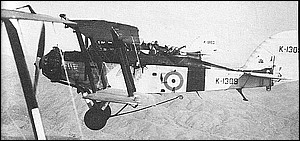 |
One of the aircraft that Ratnagar flew regularly during his stint with 2 Squadron was Wapiti K-1309, seen here during its service with 5 RAF Squadron. |
In December No. 2 Squadron got its first ‘modern’ aircraft – the Westland Lysander II. The Lysander was a high wing monoplane Army Cooperation aircraft with fixed undercarriage and low speed flying capabilities. For the pilot flying it, it offered the comfort of an enclosed cockpit – and a fantastic field of view in terms of observation on the ground. No.1 Squadron had already been operating the Lysander for a couple of months. No.1 had taken part in a public flypast in Calcutta the month before and made a name for themselves flying the breadth of the country twice with no accidents at all, while its co-located and similarly equipped sister- and the occasional rival unit, No.28 Squadron RAF, had three accidents during the same journey!
3rd December was the day that Ratnagar got his hands on a Lysander for his first ‘Solo on type’. He undertook a familiarization sortie in L-1244. He carried no gunner in the rear cockpit at that time, but the tail was weighed down with ballast to simulate the correct center of gravity.
Not long after, the Japanese attacked Pearl Harbour, and World War Two spread to the Far East. Within no time, the British were facing another enemy knocking on the doors of their colonies in Asia.
On 21st December, Pilot Officer Ratnagar was posted out to join No.1 Squadron flying Lysanders. No.1 Squadron at that time was under the command of the legendary “Jumbo”, Sqn Ldr KK Majumdar. The squadron was preparing to move up to the Burma front to support the operations of the Indian and the British armies.
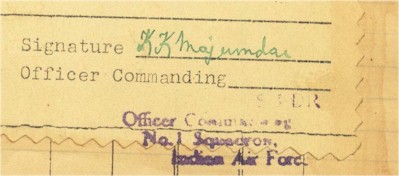 |
Lysanders into Burma
From the middle of January, as arrangements were made to move the ground personnel to the front in Burma, the pilots of No.1 Squadron kept themselves busy by flying practice sorties in the Lysanders. Duties included Air to Air gunnery sorties in which not only did the gunner get to fire the twin machine guns in the rear, but the pilot too got to use his unique forward-firing guns. The Lysander had two Browning machine guns that were installed in the main gear spats, which fired outside the arc of the propeller.
A small mishap occurred on January 16th, when Pilot Officer Satyanarayana overshot the runway while coming to the land at Peshawar and swung into the soft ground on the left. Ratnagar was coming in just behind Satyanarayana and he steered his Lysander P-1675 to the right, to avoid Satyanarayana’s aircraft, and bogged down in soft ground himself, with light u/c damage. The last aircraft of the formation, flown by Ananthanaryan, also suffered an accident. Then crew chief, Warrant Officer Harjinder Singh, in his biography, writes how Majumdar grimaced at the news of three aircraft accidents in quick succession. However, due to the undaunted efforts of the ground crew at Peshawar, all the three aircraft were salvaged and repaired in time for the pending move to Burma five days later.
When the time came for the squadron to move to Burma on 21st January, the movement was done lock stock and barrel.
As Ratnagar describes it,
“Nobody had advised us on what to do. We took our civilian clothes, we took our tennis rackets, we took all … [kinds] of other things. I packed my blazer in the trunk expecting to use it on the front. We had trunks full of … [such things] which were loaded in the Lysander aircraft.”
The Lysanders carried a crew of two. With Sgt Ashraf as his gunner, Ratnagar flew Lysander DG447 into Toungoo on February 1 [2]. The flight route taken by the squadron was Peshawar – Lahore – Gaya – Calcutta – Chittagong – Akyab and Toungoo. The ground party consisting of the airmen and technicians had already moved to Toungoo.
There was no flying for Ratnagar on the day he landed in Burma, but on the day Majumdar led the squadron on its famous raid to Mae-Haungsang, an important visitor to Toungoo was being prepared for a flight to another place.
One of the pilots of the squadron, Pilot Officer Satyanarayana was detailed to fly a Chinese General named Yun to Lashio. Before starting, Satyanarayana helped the General into the rear seat of Lysander P9131 and helped strap him in his seat. Having made sure his passenger was secured, Satyanarayana jumped from the side of the rear cockpit to the ground. As he jumped, a ring he was wearing on his right hand got caught in the ammunition box stowage on the air gunner’s Lewis Gun. The ring cut through Satyanarayana’s skin, nearly severing his finger in the process.
Satyanarayana fell to the ground in pain, the ring having very nearly severed his finger completely. “It was hanging by just the flesh” recalls Ratnagar. Satyanarayana shouted in pain and passed out. The Squadron doctor came up and inspected Satyanarayana. It was pretty obvious that he was not going to do any flying. It was an awkward situation, Gen Yun was sitting in the rear seat of the Lysander, all strapped in and ready to go, and there was no pilot to fly him!
The Flight Commander, Flt Lt Niranjan Prasad, after being appraised of the situation, told Ratnagar to carry out Satyanarayana’s sortie and drop Gen Yun off at Lashio. Cursing his luck, Ratnagar started the Lysander, flew all the way to Lashio, and dropped the General off. For the return trip, the Lysander carried the ADC to the GOC of NorGroup from Lashio to Toungoo and thereafter to Mingaladon airfield at Rangoon.
Most of the squadron’s work in Burma was intended to be “Army Cooperation” – providing transport to important Army Officers, reconnoitering enemy positions. The CO, Jumbo Majumdar, added another role, and made it their own – Bombing and Ground Attack!
The following days were spent in carrying out more Army Cooperation sorties between airfields in the Rangoon area. Operating from Mingaladon airfield, the Lysanders flew sorties to satellite airfields like Johnny Walker, Johnny Haig, Z etc. The missions flown by Plt Offr Ratnagar include two bombing sorties on Dimenez and Martaban carried out on the 15th and 17th . These, Ratnagar recollects, were against ground troops. The Lysanders never encountered air opposition throughout their campaign. On the second raid on Martaban, Ratnagar remembers encountering accurate ground fire from the Japanese. A couple of bullets actually hit his Lysander, though neither he nor his gunner Sgt Ashraf was hit. This did earn a “very effective fire” remark on the AA in his logbook!
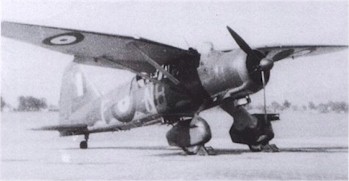 |
Lysander N1255 in No.1 Squadron codes NB-F. Ratnagar flew this aircraft on February 20, 1942 from satelite airfield ‘Z’ to Johnny Haig. Photo Courtesy: RAF Kai Tak Records via Warpaint Books |
The ground crew ably supported the pilots and gunners on their daily missions. Ratnagar fondly remembers the ‘Parsi gang’ – a group of Parsi airmen who had earned a reputation as a mischievous lot; capable in their way but sometimes difficult to control. They would often engage in group activities like singing and playing music, keeping their spirits up even under the hard conditions at Mingaladon. Two particular names stand out – AC Irani and Ilavya (Read Hoshang Patel’s recollections on Ilavya).
Ratnagar also recollects other colleagues who were flying these Army Cooperation sorties over Burma. One of them was Pilot Officer Hrushikesh Moolgavkar, a Maharashtrian who would later earn a fearsome reputation as a spirited flier as well as a strict disciplinarian. He would ultimately climb to the top slot of the post-War Indian Air Force as Chief of Air Staff! (1975)
Moolgavkar and Ratnagar were friends and had met first during their training days in Ambala. Now flying operations in Burma, they shared a common passion for the non-vegetarian food served in the Officers’ Mess. While many of the other officers, some from devout Hindu families, would abstain from eating non-vegetarian food, Ratnagar and Moolgavkar would not hesitate to corner meat rations that were left unclaimed. Moolgavkar had a habit of instructing the bearer even before lunch was served that “Yeh Saab nahin khayega, woh Saab nahin khaayega, jo bhi bach jayega, poora hamare pass le ke aao!” (This gentleman won’t eat this, those gentlemen won’t eat it either, whatever is left, bring the whole lot here!).
Ratnagar also recollects sharing the tent one night with Moolgavkar and watching him display his famous temper. The adjoining tent had a couple of officers, who were relatively young and inexperienced compared to Ratnagar and Moolgavkar. These two had at least seen some flying and operations over the NWFP against the tribes supporting the Fakir of Ipi, before coming to Burma. The two officers in the adjoining tent had come to Burma fresh from flying school, and were a little concerned about the bombing that had taken place over the past few days and the news of the Japanese advances across Burma. Naturally, there was some animated discussion in the tent about the overall campaign and the likely fate of the squadron. As the discussion took an increasingly animated tone, with concern expressed on the lines of “Yeh kya ho raha hai, ab hamara kya hoga” , Moolgavkar who was trying to sleep and keep his temper down could take it no longer. He shouted at the top of his voice “Shut up you b*****ds, you guys don’t like this then go back to India, you @#$.”. Not surprisingly, everything was quiet after that.
On February 21st, with the Japanese closing in on Rangoon, it was decided to send the three Lysanders remaining at Mingaladon back to India. The flight at Lashio was to stay on. That morning three pilots of ‘B’ Flight, Flt Lt Niranjan Prasad, Pilot Officer Ibrahim, and Homi Ratnagar, gathered with their gunners. Ratnagar was sent to Johnny Walker airfield together with his gunner, Sgt Ashraf, on one last important communications sortie. He knew that the other two Lysanders would already have left Mingaladon, by the time he came back from JW. Ratnagar admits to having some qualms at the time, but Niranjan Prasad encouraged him to carry out the sortie and rely on catching up with the others on their way out of Burma.
By the time Ratnagar came back to Mingaladon, both Prasad and Ibrahim had already taken off and left. Ratnagar knew that he was on his own, at least till he caught up with the others along the way. Ratnagar took off, carrying out possibly the last Lysander departure from Rangoon before it fell to the advancing Japanese. He was able to catch up with Niranjan Prasad and Ibrahim on the route back somewhere near Gaya, after a day or so.
From Gaya, the three Lysanders headed for Secunderabad via Nagpur. The designated airfield for Nagpur was actually at Kamptee, which was a very small airfield. The first impression of the pilots when they saw the airfield was “My God! Itna chota sa hai! Will we be able to land?“.
Yet again, the STOL capabilities of the Lysander were put to good use. The Lysander could hold off the stall down to a speed as low as 55mph! The pilots just had to fly the aircraft down to that slow speed while approaching the runway, and the aircraft would take on the landing attitude and descend gracefully onto the ground. After refueling and rest in Nagpur, the final leg of the trip, to Begumpet airport in Secunderabad, was done in quick time. This was on 2nd March.
Ratnagar’s aircraft was effectively the last Lysander out of Burma that flew back under an Indian pilot. All the remaining Lysanders on the strength of No.1 Squadron in Burma were either lost in the Japanese bombing of airfields, or in operations, or were handed over to the Burma Volunteer Air Force.
The rest of No. 1 Squadron caught up with them by middle of March. All the other pilots including Majumdar, Raza, Rajinder Singh, Moolgavkar, Satyanarayana etc came by American aircraft or by transport ship.
So it turned out that Ratnagar’s Lysander P9180 was one of the few aircraft that came back to India from that First Burma campaign. This aircraft had an interesting history: Before the Burma Ops, it had been nearly written off during training when Pilot Officer Runganadhan pranged the aircraft at Peshawar. Only the sheer resourcefulness of the technical staff led by Sgt Harjinder Singh managed to put the aircraft back in the air. Later P9180 was to be the first Lysander to be equipped with the ‘Prototype’ wooden tail wheel. This aircraft now went back to a training establishment and was lost in an accident in 1943.
Rest and Re-Formation at Begumpet
Ratnagar’s logs show that flying resumed in earnest again in April 1942. Local flights were made to Bombay, Ahmedabad, Kamptee – and a sortie even to Delhi. The trip to Bombay was actually a ‘thank you’ visit made to the people of Bombay, whose subscriptions had paid for the Lysanders of No.1 Squadron.
Soon after their arrival at Secunderabad many of the Pilot Officers received their promotions to Flying Officer. The officers used to visit the Secunderabad Club during their stay. At that time, the fee to become a permanent member was only Rs 50. And it could be paid in installments of Rs12.50 every month. It turned out to be a good move; when they became Flying Officers the whole squadron had a big party in the club.
One of the colorful characters at Begumpet with the Squadron was Fg Offr Anwar Afridi, who was the adjutant of the Squadron. Afridi was tall and endowed with dashing good looks. He had a reputation for succeeding with women, once even earning a rocket from Subroto Mukerjee for bringing a lady into his quarters even though that was prohibited at that time. As Fate would have it, Afridi fell for the charms of the lovely daughter of the Chief of Army Staff of the Hyderabad Army – Maj Gen El Edroos. To complicate the matters, the General was strongly opposed to the alliance, but Afridi managed to work his way eventually into the good books of the General and married his daughter. After partition, they moved to Pakistan and did very well.
On 20th May, the Squadron moved from Begumpet to Trichnopoly. Ratnagar and others flew their Lysanders south to Trichy. Not long after they set up camp there, they were told that No.1 Squadron was to convert to the Hawker Hurricane fighter-bomber, the first unit in the Indian Air Force to do so. Accordingly, under Mukerjee the first batch of 14 pilots and 45 airmen proceeded for Hurricane conversion at Risalpur on 25th June.
Ratnagar was to be one of the first 14 pilots selected to undergo the conversion at 151 OTU. The conversion included getting the feel of a monoplane fighter – so the first aircraft that the Indian pilots learned to fly there was the two-seater Harvard trainer. The pilots were allowed to get a feel of operating the Harvard and executing full-fledged aerobatics in the aircraft. Since there was no two-seater Hurricane available, the pilots would have to graduate from the Harvard to the Hurricane directly. Ratnagar flew about five sorties in the Harvard before going on his ‘Solo’ in a Hurricane Mk I towards the end of June.
Surprisingly after doing about six sorties in the Hurricane, Ratnagar was asked to fly the Curtiss P-36 Mohawk, a precursor to the famous P-40 Tomahawk fighter. His first solo flight on the Mohawk was on 6th July 1942 on Mohawk LA164.[3]
Once proficiency was gained on the Hurricane, the Squadron proceeded to do Air to Air and Air to Ground gunnery practice over the following months. More often than not, the aircraft towing the target drogue was a Lysander, the same type that they had been flying till recently. Towards September, No.1 Squadron went to Karachi to collect their own Hurricanes.
Ratnagar had an accident in a Hurricane in October 1942 and had to be hospitalized for some time. He did not fly again till towards the end of November when he joined up with the Squadron at Trichnopoly again. By this time Sqn Ldr SN Goyal had taken over command on 1st December.
From then, and into the new year of 1943, No.1 was based at Trichinopoly while deploying for exercises all over South India. In February 1943, Goyal took the squadron to Bairagarh in Bhopal for gunnery exercises. Then the squadron moved again in the following months, first to Charra near Ranchi in Bihar (March 43) and then to Risalpur (April 43). During this time, Ratnagar was in Flt Lt Arjan Singh’s flight and one of the many photographs from that time shows Arjan Singh with members of ‘A’ Flight in front of a Hurricane.
Starting on 8th April, Ratnagar left the squadron to attend an Administrators Staff course, which lasted about 20 days. As soon as the course was over, he proceeded on leave to Bombay for his marriage, which was to be on 20th of May. Leaving his wife back in Bombay, Ratnagar returned to Risalpur by the 5th of June. Hardly another two weeks had gone by when he received orders posting him to No.2 Squadron.
Posting to No.2 Squadron
Ratnagar arrived at Trichinopoly to take over one of the Flights of No 2 Squadron on 25th June 1943. Sqn Ldr SS Majithia was then commanding the Squadron.
This time, Mrs Ratnagar accompanied him and they set up house at Trichinopoly. Much to the Ratnagars’ delight, another friend from his training days was also there – Fg Offr P F Reporter. Reporter was at that time with No.6 Squadron and was staying with his wife near the Ratnagars. Quite naturally the families used to get together often for lunch or dinner. Later when No.6 Squadron went to the front, Reporter left his wife behind to stay with the Ratnagars. But a tragedy was in store for Reporter. On the last day of 1943, December 31st, Reporter crashed while low flying over a marshy area.
No.2 Squadron had moved to Kohat at the same time that No.6 had moved to the Burma Front. It was at Kohat that Ratnagar received the sad news of Reporter’s death. Later after operations, when he went to Bombay, he paid a visit to Mrs. Reporter. Mrs. Reporter had received the official telegram and letter from the Air Force informing her about the crash and her husband’s death. But she still clung to the belief that her husband was alive but missing. She had based this assessment on the fact that Reporter’s body was not recovered from the crash site. She had questioned Minoo Engineer in-depth about the possibility of her husband’s survival when he visited her earlier, and in spite of Minoo’s best efforts, she had not accepted the sad reality. Now it happened again with Ratnagar. Ratnagar was not able to convince her either. Sadly, Mrs. Reporter never accepted the death of her husband, and clung to the vain hope that he was alive, well into her old age and until her own death. There is an element of unmistakable sadness when Ratnagar talks about his friend.
Operations at Kohat
Life in the North West Frontier Province was anything but dull. Even though it was far away from the scene of operations on the Burma front, the NWFP has a number of its own operational requirements. The days at Kohat were spent in flying leaflet raids on the villages in NWFP, conducting road recces, and even a few bombing raids against ‘hostile’ targets. The squadron also received an influx of new pilots – Ratnagar spending a significant amount of time checking out the pilots in the Harvard as well as flying his usual quota of sorties. On February 28, Pilot Officer Rai force landed due to engine failure in his Hurricane and Ratnagar went up in a Hurricane to look for him. However Rai made it safely back to airbase even before the rescue parties could go out for him.
In May 44, Sqn Ldr Kanwar Jaswant Singh took over command of the Squadron. “Tiger” Jaswant Singh, as he came to be known, was another officer who started his service career in the Indian Army. But he was one of the few who transferred permanently to the Indian Air Force. [4]
There were a few RAF officers with No.2 Squadron for some time. When asked how the relationship was between Indian and British officers, Ratnagar says that they generally got along fine. In some extreme cases, some British officers did display racist tendencies and referred to Indians as ‘blackies’, but they were few and far apart. By and large, the quality of officers and men was good. Ratnagar observes that most of the British officers and men of that period were not career officers but conscripted during the war. He believes that they grew up with fewer inherent notions of superiority than some pre-War regular officers might have had.
The Lady in the Hurricane
No.2 Squadron moved out of Kohat on 1st of August. Over the next five days the Hurribirds of No.2 made their way across the country to Kalyan. The move was completed by the 5th. Sqn Ldr Kanwar Jaswant Singh was still the CO, while Ratnagar was the Flight Commander of A Flight and Flt Lt Yeshwant Malse, another veteran from No.1 Squadron’s Lysander days in Burma, was the other Flight commander. While talking about that period Ratnagar mentioned an anecdote involving his friend Minoo Engineer.
“There was one incident that I remember very clearly. Ask Malse about it Ask him about the lady in the Hurricane”
Lady in a Hurricane? Now how did that happen?? Ratnagar then proceeded to give us the whole story.
One fine morning, Minoo Engineer came into Ratnagar’s office in Kalyan. Minoo told Ratnagar that he wanted to fly a Hurricane urgently and that he should ‘give him one’. Ratnagar sensed that Minoo was under some kind of pressure and asked him what all the urgency was about. Nothing could have prepared him for the answer that came back. Minoo revealed that he had once, a long time previously promised a lady friend of his that he would take her up in a Hurricane. Now the lady was pressing Minoo to redeem his promise. It had come to such a stage that Minoo had decided to take her up somehow, and presented himself at Ratnagar’s office together with the lady in question.
Ratnagar was shocked at what Minoo was planning to do. He told Minoo that his scheme would land all of them in trouble, and he wanted no part of it. But Minoo would not take no for an answer. Perhaps the adventurous streak in Ratnagar persuaded him to help Minoo out. Ratnagar eventually told Minoo that while he would do what he could to help, he could not be seen to do so as the Senior Flight Commander. He suggested that Minoo take an aircraft from ‘B’ Flight – then under Flt Lt Malse. So they all went to Malse’s office with the proposal. Malse’s first reaction was no different from Ratnagar’s. He was horrified at the prospect of such an unofficial passenger. What if there was an accident? How would it be explained? And how could Minoo take the lady into the aircraft in front of all the airmen?
Finally, the three came up with a solution. Minoo took a Hurricane from Malse’s flight and taxied it to the far end of the runway, out of view of the other ground crew and the ATC. Ratnagar and Malse then took the lady in a car to the runway end where the Hurricane was ticking over. The ‘transfer’ took place there. Minoo Engineer took off his parachute and sat in the bucket seat and the lady sat in Minoo’s lap. The Hurricane took off, did a leisurely circuit, landed, and taxied back to the end where the car was still waiting. The unauthorized passenger was again ‘transferred’. Everyone went back to their regular jobs as quietly as they could. But the secret was not kept for long; the lady was so happy at her joy ride that it soon became the talk of the town!
Though Ratnagar came through all this thinking of it as a big joke at the time, he remarks that in retrospect both he and Malse were quite shaken by thoughts of the ramifications if something had gone wrong. [5]
The Second Tour – Into Burma
The Third Arakan campaign (Arakan Offensive) in Burma started in earnest in December 1944. The objective was to capture the Mayu Peninsula, Akyab, and Ramree Island, which would provide forward airfields for the support of Fourteenth Army in their thrust into Central Burma. The theatre saw the highest concentration of IAF squadrons in action at any time, a total of six squadrons being committed for this purpose. One of the squadrons that had moved to the area was No.2 Squadron, which had moved to Mambur airstrip near Cox’s Bazaar by land towards the end of November 1944.
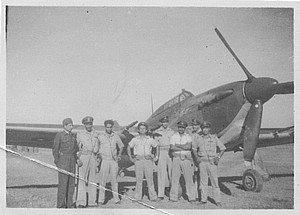 |
Sqn Ldr Kanwar Jaswant Singh (Center) with Flt Lt H Ratnagar to his left along with members of No.2 Squadron at Akyab |
From 23rd November 1944, when they arrived at Mambur airstrip, till 17 May 1945, when their tour ended, the squadron was involved in flying fighter recce missions. The task of the squadron was to collect information on Japanese activity by either visual observation or photographic means. Over the following weeks, the Squadron would provide recce cover to the army during ops in the Mayu Peninsula, Kaladan Valley and for the Invasion of Ramree Island. Ratnagar flew a recce sortie on 2nd December 1944, covering the Buthidaung area. The same day Fg Offr K V Nair from Ratnagar’s flight failed to return from one of the recce missions. It later turned out that he was captured by the Japanese and taken POW.
From then till the end of the month, Ratnagar flew 22 recce sorties totaling 28 hours. Almost all the ops were Tac/R, with a sprinkling of message drops and photo drop sorties. There were more casualties in the flight. Fg Offr Sharma from Malse’s flight went missing in the Kaladan and on the last day of the month, Plt Offr Juvekar was killed in a crash at Buthidaung.
The next month, January 1945, saw No.2 Squadron in the thick of the action again, providing recce in the Kangaw area. In preparation of the assault on Ramree Island, which housed a key airstrip that was necessary for the allied forces, Ratnagar’s flight was moved to Akyab from Mambur on 20th January. The next day was ‘D’ Day, when Allied troops landed on Ramree. There was fierce Japanese opposition to the Allied assault. ‘A’ Flight carried out recce over the entire island over the next few days. On the very first day over Ramree, 21st Jan, Ratnagar felt his aircraft hit by ground fire. There was a jolt and a “thud” that he could feel below his seat. On returning to Akyab, he found that it was a single Japanese .275 caliber bullet that had gone through the cockpit floor and through the seat plate. It had lodged itself in his parachute. No wonder Ratnagar recalls that it felt like a kick at that time!

Ratnagar and ‘A’ Flight took a break from the usual recce missions by strafing boats in the Hopantha area on the 27th. They had noticed these boats the day before. Ramree Island had already fallen to the Allied troops and the airfield was activated for Allied aircraft soon after. Ratnagar made the first landing at the captured airfield of Kyakphu on the 29th and soon after did some local Tac/R sorties in the area. [For the month of January, Ratnagar did 23 sorties totaling 30 hours of flying.] The rate of sorties put out by No 2 Squadron was phenomenal. For example, the month of January 1945 saw the unit putting up 548 sorties. A price was paid once again, ‘A’ Flight lost Bob Kumar over Ramree in the days following the landing.
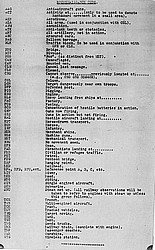 |
The Reconnaissance Codes cards used by the Hurricane pilots for making notes on the map or for transmission to the ground . |
Operations tapered off a little after February 11th and the flying effort was reduced considerably. The pilots engaged themselves in flying still more recce sorties over the coming months.
Ratnagar took 20 days’ leave towards the end of March till the 2nd week of April. After returning to the squadron, he flew more Tac R sorties during the months of April and May.
After four and a half months, No.2 Squadron was moved back from the front. Starting their move on 15th May from Akyab, the pilots flew their battle-tested and worn-out Hurricanes all the way across the sub-continent, from Akyab to Kohat, staging through Hazarpore, Alipor, Ranchi, Gaya, Allahabad, Kanpur , Delhi and Lahore. They reached Kohat on May 22nd for a well-deserved rest.
RAF Staff College Haifa
The War in Europe has already ended when No.2 Squadron prepared to come back. On 6th August , the ‘Tall Boy’ atomic bomb was dropped on Hiroshima hastening the end of the war.
Around this time, Ratnagar was sent to do a Staff course at the RAF College in Haifa, in Palestine. Ratnagar was still a Flight Lieutenant at that time with No.2 Squadron at Kohat. He would have to don the stripes of a Squadron Leader before moving to undergo the course. Ratnagar’s wife was sent to Karachi and he himself proceeded to the RAF Staff College. By that time the second atomic bomb was dropped on Nagasaki and the Japanese sued for peace. Ratnagar went to Haifa via Cairo. While he was in Cairo, VJ Day was declared. He reached Haifa on 16th August.
The Course lasted from 16th August 1945 to 9th February 1946. All the students of the course were accommodated in a hotel in Palestine. The daily routine was to attend class and then come straight back to the hotel.
Ratnagar recollects that the signs of the impending conflict in the Middle East were already there. Palestine was the designated homeland for people of Jewish origin but under British protection. There was huge discontent against the British presence on the part of both the Jewish as well as Arab people. There were quite a few insurgent attacks during his stay. On one occasion, the guerillas tried to roll grenades into the open-top truck in which the students of the Staff College were traveling!
So movement in the area was always done under the cover of a security team. Being an Indian had its advantages, as Ratnagar found out. He could move around the country without appearing conspicuous, as people of Caucasian origin would find themselves to be. Ratnagar teamed up with an Indian doctor who was also undergoing the Staff College course. And together they were able to explore Haifa.
Staff College in itself brought about a series of revelations for the young Squadron Leader. Most of his classmates on the course were from the RAF, holding the ranks of Group Captains and Wing Commanders. Almost everyone sported a wartime decoration like the DSO, DFC or the OBE. It was a unique distinction for him as a newly promoted Squadron Leader to be rubbing shoulders with several war heroes from the European theatre.
The second revelation was the composition of the course content. Ratnagar himself had never been to college. His highest academic qualification was just that of a school leaver – because he had taken up flying as a career, he had given up on college. Now meeting the academic demands of the Staff College course was turning out to be quite a task!
Ratnagar recollects that they were given an assignment – to write essays on specified topics. As someone who had spent more time flying and fighting than in producing structured written work, he found it difficult to do that. So Ratnagar approached the Commandant and appraised him of his background. He told him that his formal education was limited, but that he was willing to try his best. Ratnagar recalls that the teaching staff of the college were very helpful, and made special efforts to help him – this only strengthened his belief in the ‘fair play’ of the British.
It was this kind of help that saw him pass through Staff College. After completion of the course, Ratnagar made his way back to India. Ratnagar is proud of having passed out of a specialist Air Force Staff College. It allowed him to use the post-nominal psa “Passed Staff College – Air Force” at the end of his name in correspondence or in Air Force lists. The psa post-nominal is differentiated from the more common psc (passed Staff College), which is used for the graduates of joint Staff Colleges, like the DSSC at Wellington in India.
Typically the Staff College tenure would have meant no flying for the period. But Ratnagar still managed to get some flying done. His first multi-engine experience came while flying as a second pilot in an Anson at Ramat David, followed by another sortie in it as the first pilot. Once the course was done, Ratnagar got a ride in a Proctor that was going from Ramat David to Egypt, from where he came back to India.
End Notes:
[1]. Interestingly Ratnagar was given the service number IND/1588. He was just 37 places behind Subroto Mukerjee, the seniormost Indian officer, whose service number was IND/1551. Over the course of the war and Independence, as pilots perished in training or on operations, or decided to leave the air force, this gap shrank and at one stage in his career, Ratnagar found himself the 13th seniormost officer in the Indian Air Force after Subroto.
[2] Lysander DG447 was an aircraft that served with 440 RCAF Squadron before transferring to the SEAC
[3] It is not known as to why the pilots were told to become proficient on the Mohawk, the only speculation that the author can offer is that there may not have been enough Hurricanes available at that time.
[4] Tiger would later post some notable achievements, including becoming the only IAF officer to command a foreign air force. He was deputed by the Government of India to raise the Ghanaian Air Force in 1960. He later commanded Eastern Air Command during the 1962 Indo China Conflict.
[5] This was probably the FIRST occasion that a lady was to fly in an Indian Air Force fighter – albeit unofficially. This incident is also mentioned in Wg Cdr Murkot Rammunys Autobiography ‘The Sky is the Limit’. It would be many decades later that the first official flight for women in IAF fighter aircraft happened when a lady Medical Officer in a Hunter Squadron was given her ‘Air Experience Sortie’ in a two-seater Hunter.
Acknowledgments:
Air Commodore H S Ratnagar (retd) for providing time for a personal interview and then providing his logbook and photographs
K S Nair for taking the effort to edit this document to weed out all errors and typos.
Paul Mc Millan for providing me with provenance and fates of the Lysanders DG447 and P9180 and other aircraft of No.1 Squadron
Epilogue: (Added 23rd March 2004)
I had met Air Commodore Ratnagar for the last time on 27th November 2003. I went to return his photographs and logbook and we chatted for about half an hour about it. Part 1 of this article went online on 1 Jan 2004, and Part II on 1 Feb 2004.
In the first week of February 2004, Air Commodore Ratnagar lost his wife – they had been married for over sixty years. It was a sad loss for him. Less than two months later, on 19th March 2004, Air Commodore Homi Shapurji Ratnagar, breathed his last. One of the pioneer ‘Tigers’ had now taken off for his final sortie. I regret that I was not able to meet him again after the last meeting in November, though I wanted to. Sir, RIP.
